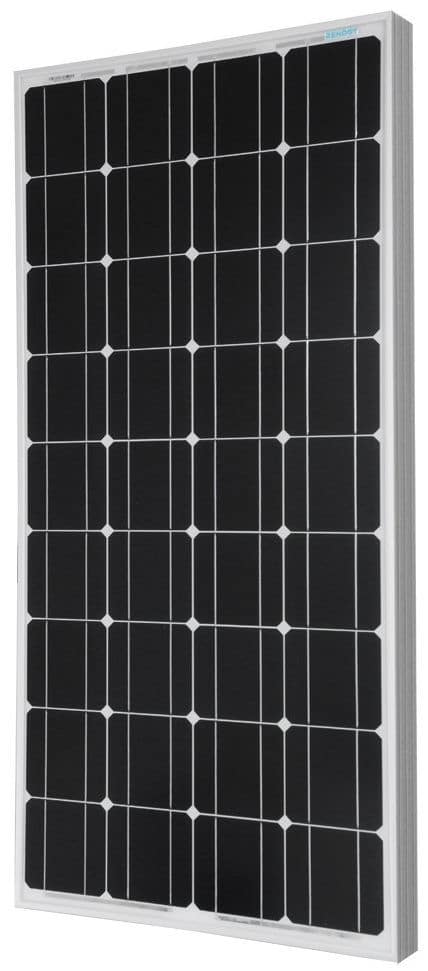
Connecting Solar Panels Together
How to Connect Solar Panels Together
![]() Connecting solar panels together is a simple and effective way of increasing your solar power capabilities. Going green is a great idea, and as the sun is our ultimate power source, it makes sense to utilize this energy to power our homes. As solar power becomes more accessible, more and more homeowners are buying photovoltaic solar panels.
Connecting solar panels together is a simple and effective way of increasing your solar power capabilities. Going green is a great idea, and as the sun is our ultimate power source, it makes sense to utilize this energy to power our homes. As solar power becomes more accessible, more and more homeowners are buying photovoltaic solar panels.
However, these photovoltaic solar panels can be very costly so buying them over time helps to spread the cost. But the problem then becomes how do we connect these extra solar panels together to increase the voltage and power output of what’s already there.
The trick here when connecting solar panels together is to choose a connection method that is going to give you the most energy efficient configuration for your particular requirements.
Connecting solar panels together can seem like a daunting task when you first start to look at how it should be done, but connecting multiple solar panels together is not that hard with a little thought. Wiring solar panels together in either parallel or series combinations to make larger arrays is an often overlooked, yet completely essential part of any well designed solar power system.
There are three basic but very different ways of connecting solar panels together and each connection method is designed for a specific purpose. For example, to produce more output voltage or to produce more current.
Solar photovoltaic panels can be electrically connected together in series to increase the voltage output, or they can be connected together in parallel to increase the output amperage. Solar pv panels can also be wired together in both series and parallel combinations to increase both the output voltage and current to produce a higher wattage array.
Whether you are connecting two or more solar panels, as long as you understand the basic principles of how connecting multiple solar panels together increases power and how each of these wiring methods works, you can easily decide on how to wire your own panels together. After all connecting solar panels together correctly can greatly improve the efficiency of your solar system.
Connecting Solar Panels Together in Series
The first method we will look at for connecting solar panels together is what’s known as “Series Wiring“. The electrical connection of solar panels in series increases the total system output voltage. Series connected solar panels are generally used when you have a grid connected inverter or charge controller that requires 24 volts or more. To series wire the panels together you connect the positive terminal to the negative terminal of each panel until you are left with a single positive and negative connection.
Solar panels in series add up or sum the voltages produced by each individual panel, giving the total output voltage of the array as shown.
Solar Panels in Series of Same Characteristics
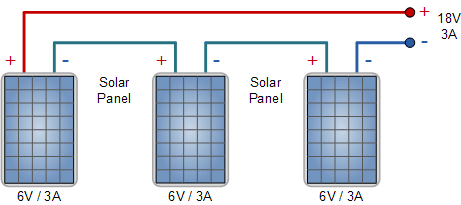
In this method ALL the solar panels are of the same type and power rating. The total voltage output becomes the sum of the voltage output of each panel. Using the same three 6 volt, 3.0 amp panels from above, we can see that when these pv panels are connected together in series, the array will produce an output voltage of 18 Volts (6 + 6 + 6) at 3.0 Amperes, giving 54 Watts (volts x amps) at full sun.
Now lets look at connecting solar panels in series with different nominal voltages but with identical current ratings.
Solar Panels in Series of Different Voltages
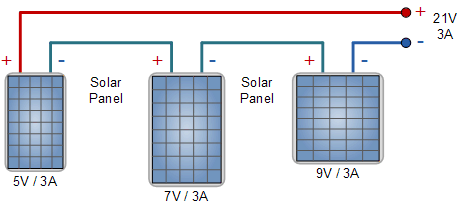
In this method all the solar panels are of different types and power rating but have a common current rating. When they are connected together in series, the array produces 21 volts at 3.0 amps, or 63 watts. Again the output amperage will remain the same as before at 3.0 amps but the voltage output jumps to 21 volts (5 + 7 + 9) .
Finally, lets look at connecting solar panels in series with completely different nominal voltages and different current ratings.
Solar Panels in Series of Different Currents
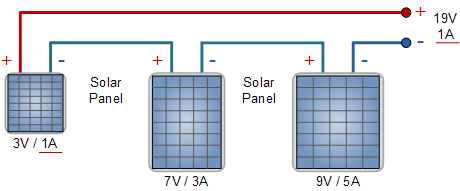
In this method all the solar panels are of different types and power rating. The individual panel voltages will add together as before, but this time the amperage will be limited to the value of the lowest panel in the series string, in this case 1 Ampere. Then the array will produce 19 Volts (3 + 7 + 9) at 1.0 Ampere only, or only 19 watts out of a possible 69 watts available reducing the arrays efficiency.
We can see that the solar panel rated at 9 volts, 5 amps, will only use one fifth or 20% of its maximum current potential reducing its efficiency and wasting money on the purchase of this solar panel. Connecting solar panels in series with different current ratings should only be used provisionally, as the solar panel with the lowest rated current determines the current output of the whole array.
Connecting Solar Panels Together in Parallel
The next method we will look at of connecting solar panels together is what’s known as “Parallel Wiring“. Connecting solar panels together in parallel is used to boost the total system current and is the reverse of the series connection. For parallel connected solar panels you connect all the positive terminals together (positive to positive) and all of the negative terminals together (negative to negative) until you are left with a single positive and negative connection to attach to your regulator and batteries.
When you connect solar panels together in parallel, the total voltage output remains the same as it would for a single panel, but the output current becomes the sum of the output of each panel as shown.
Solar Panels in Parallel of Same Characteristics
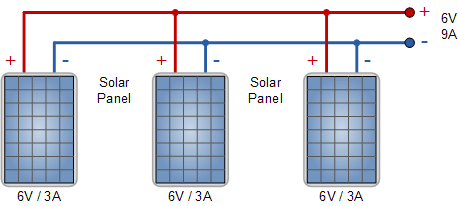
In this method ALL the solar panels are of the same type and power rating. Using the same three 6 Volt, 3.0 Amp panels as above, the total output of the panels, when connected together in parallel, the output voltage still remains at the same value of 6 volts, but the total amperage has now increased to 9.0 Amperes (3 + 3 + 3), producing 54 watts at full sun.
But what if our newly acquired solar panels are non-identical, how will this affect the other panels. We have seen that the currents add together, so no real problem there, just as long as the panel voltages are the same and the output voltage remains constant. Lets look at connecting solar panels in parallel with different nominal voltages and different current ratings.
Solar Panels in Parallel with Different Voltages and Currents
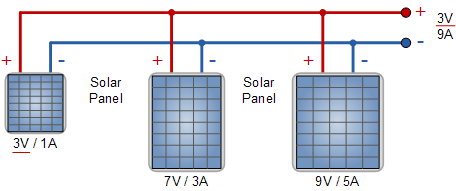
Here the parallel currents add up as before but the voltage adjusts to the lowest value, in this case 3 volts or some voltage value very close to 3 volts. Solar panels must have the same output voltage to be useful in parallel. If one panel has a higher voltage it will supply the load current to the degree that its output voltage drops to that of the lower voltage panel.
We can see that the solar panel rated at 9 volts, 5 amps, will only operate at a maximum voltage of 3 volts as its operation is being influenced by the smaller panel, reducing its efficiency and wasting money on the purchase of this higher power solar panel. Connecting solar panels in parallel with different voltage ratings is not recommended as the solar panel with the lowest rated voltage determines the voltage output of the whole array.
Then when connecting solar panels together in parallel it is important that they ALL have the same nominal voltage value, but it is not necessary that they have the same ampere value.
Connecting Solar Panels Together Summary
Connecting solar panels together to form bigger arrays is not all that complicated. How many series or parallel strings of panels you make up per array depends on what amount of voltage and current you are aiming for. If you are designing a 12 volt battery charging system than parallel wiring is perfect. If you are looking at a higher voltage grid connected system, than you’re probably going to want to go with a series or series-parallel combination depending on the number of solar panels you have.
But for a simple reference in regards to how to connect solar panels together in either parallel or series wiring configurations, just remember that parallel wiring = more amperes, and series wiring = more voltage, and with the right type and combination of solar panels you can power just about any electrical device you may have in your home.
For more information about Connecting Solar Panels Together in either series or parallel combinations, or to obtain more information about the different types of solar panels available, or to explore the advantages and disadvantages of using solar power in your home, then Click Here to order your copy from Amazon today and learn more about designing, wiring and installing off-grid photovoltaic solar electric systems in your home.





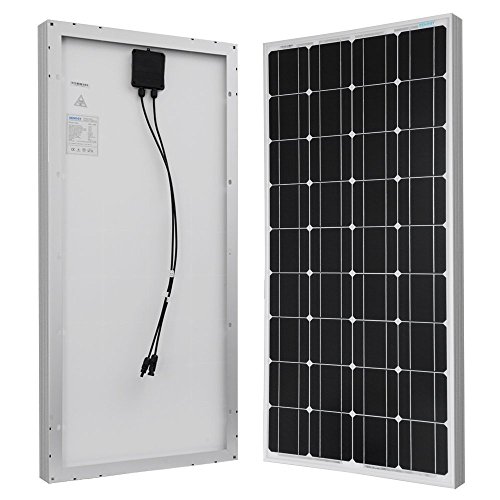





10/260w solar panel and 4/12v gel batteries with 60amps mppt controller and 3kva inverter. How best the connection to maximise the output. Thanks.
If your 260W panels are rated at 24 volts for battery charging, then your batteries are connected as 48 volt (4 series), and your panels are configured as 2S5P, (2 series 5 parallel)
Hi Admin
Let me be the first to wish you a Happy New Year
All the very best
Good morning Admin ( you are amazing at answering all the guys here) Thank you first of all for that
I have 8x 335w panels. I have added Inverter specs below . My problem comes to the MPPT input 115vdc
I ran 2x 6mm strings and can either series them or parallel them at the inverter
HOW do I get my Solar to give me close to 115v . I get 82volts at present BUT when it goes to 84v MPPT switches off and refuses to accept more power. (Is this the case with all MPPT??)
What config can I use to get Optimum voltage and wattage out of my system ? Can be a mixture of series and parallel. That is now 2 Questions .. I have used a 3,5KW Lithium 48 volt battery
Thanking you in Advance
Domingos
VOLTEX 5KVA
Inverter Mode:
Rated power: 5000VA/5000W
DC Input: 48VDC, 117A
AC Output: 230VAC, 50/60Hz, 22A
AC Charger Mode:
AC Input:230VAC, 50/60Hz, 35A
DC Output: 54VDC
Max. 60A, Default 30A
AC Output: 230VAC, 50/60Hz, 22A
Solar Charger Mode:
Rated Current: 80A
System Voltage: 48VDC
Min. Solar Voltage: 40VDC
Max. Solar Voltage (VOC): 115VDC
115 VDC is not a common voltage compared to 125 or 145VDC. With eight 335W, 72 cell panels, four in series would give about 144VDC and three is series about 108VDC which is nearer to your 115V. Increasing from 82V to 84V maybe a small increase of only 2 volts, but the current could be increasing exponentially above the VxI power limits of the MPPT, which could be why it shuts down (or its faulty). With eight panels, the only configuration is 4 in series with 2 parallel strings, or 2 in series with 4 parallel strings.
Thanks for the reply .
May I ask you another question pls.. Say my array is only giving 84 volts.. When intensity of light increases it can go to 87 even 91 (I have been monitoring) .. IF the MPPT can go to 115v WHY does it stop charging and switches off , until it comes back down to 84 ?? Is it a safeguard or could the MPPT be faulty ??
All the very best
Why does the voltage have to go to 115V when 84 volts is sufficient, How much current is it taking?, consult the user manual about maximum ratings
I know I am being an idiot and probably a nuisance But..
Could I not just do 2x series + 2x series and Parallel them to Inverter = 84 volts 1340 watts
Anlso 2 Parallel + 2 Parallel and series them to the Inverter = 84 volts 1340 watts
So both arrays are equal to 84 volts
I am worried about the 4 in series, as that would go to 148volts
Appreciate all … Thanks
Very helpful tutorial! Thanks! 🙂
help…living in ca with power outages and fires sucks..i just got 5 315 watts 36vdc 3 255 watt 24vdc panels ..before i order things what would give me the best bang for my little bucks .i need to do this right the first time so please help…yes i will add more panels in time but need solar power cause this gas gen is killing me to run 24-7…thanks…
Why have you just gone off a bought the panels you have bought, was there no plan or thought about your requirements and system beforehand. We do not have a magic ball to see what you need, consult your local solar shop or technician.
Possible connection as:
1st string: 3 x 24V = 72 volts
2nd string: 2 x 36V = 72 volts
3rd string: 2 x 36V = 72 volts
Then 3 strings will give MPP voltage (Vmp) of 72 volts for your controller. The 5th 36V panel use for something else.
MPP current(lmp)approx 8.0 + 9.0 + 9.0 = 25 Amps for your controller. This gives about 1.8kW at full sun!!
What are requirements for this kind of system
Below is the outline of the power requirements if you can please send me through a system design and explain how you would string up the panels and why and why you would recommend the system design you put together. so the charge controller will be a 250/100 which means it can handle 250V and 100A charge current. Max PV Short Circuit current – 70A (max 30A per MC4 connection). Please also state what size battery you will use and size cables for PV to charge controller and any protections, breakers that you will add to the system for protection. Battery to be lithium ion and sized in kWh.
Power consumption details:
Average load – 1500w
Max load – 5000w (pump & kettle being used)
Backup power required in daytime is 10 hours on battery
Panels to handle load and recharge the battery during day time
IBR roofing type.
I look forward to receiving your system design,
Err, no.
Hello admin.
I’ve 12 volt battery of 4 to make 48volt. I’ve 250 watt of 8 solar panels. Please how do I connect my 8 solar panels of 250 watt to charge my 48volts battery. Do reply me
You connect your solar panels to produce 48 volts
Good evening Admin. Please I’d like to ask: what if he’s using mppt controller of say 145vdc input on solar. Can’t he connect 4×2 (ie, 4S2P)
He states the maximum open circuit input voltage (Voc) of the inverter is 115 Vdc.
How do I connect 2 x 300w solar panel with an open circuit voltage of 44.2
Either in series or parallel to whatever system you have. This is a very vague question.
Sir , please I need serious help in this his can I know the system voltage of a PV system when am having a 438panels connected in both series and parallel. The ratings of the panels are 415Wp, 61volt.
Wow, 182MW of solar (438*415Wp) and you need to ask this question. The array voltage will be decided by your series string, while the array current will be decided by your parallel branches.
Quick question. I am looking at going somewhat small. Tv, satellite, some LED lights, a laptop, a fan, phone chargers etc. I am looking at drawing about 1000w per day at the most. Just looking for an opinion on what I am looking for in a set up. Please let me know if I am close or if it will work please. I have 2 6v 230AH batteries(from golf cart) hooked in series to make 12v 230AH. 2 200watt solar panels. A 3000 watt inverter and 30A MPPT charge controller. I have been crunching numbers and trying to stay on a budget but also want to make sure the set up is sustainable. Any opinions greatly accepted. Thank you.
Could use some help ,I have 3 260watt panels going into 45amp controller to 4 deep cycle 12 volt batteries. Set up as 24 volt system . 3000 watt inverter constantly having to charge batteries via generator/charger have good sun , only have 2 led lights a 1.5 amp fan . Controller charge indicator lights go from green to yellow in less than 2hrs Other system is 6 panels and 6 batteries 2 controllers and I use 40 inch TV vacume and led lights this will last all day with a couple hrs of TV time Same panels controllers batteries anybody any thoughts what to check
sir, i have 255 watt solar panel having Vmp=166.6v Voc=143v
i have brought one MPPT charger which is set at 110v.NOW, The my solar panel through out the day does not give the voltage higher than 110v. so, will my MPPT will work below 110v. if yes than will it work at reduced volatge
A 255 watt panel will not give 110v output, more like 30 to 36 volts DC. Open Circuit Voltage, Voc is always higher than Vmp (voltage at rated power), you are quoting the reverse which is incorrect. Please check your panels datasheet to understand what you have bought.
Hallo,my solar system is 2 kva inverter rate am using pwm rated 50amps 55v DC ,my solar panels are 270watts 4pc and my my battery bank is 24V 600AH my system is not giving me the right running hourshours,what could be issues
Not enough sunlight (irradiance), not enough solar panels (m2), consumption too high (high kWr), system not efficient, the list continues.
what about one 150W, 12V panel and another 40W 12V panel in parallel for a MPPT controller ? same voltage, but different current
You can connect panels in parallel of the same voltage. The output current will be the sum of the two (or more) panels
Great site! New to solar so I visit quite often!
preparing to participate on a 2 month off grid adventure in a month . Unable to mount anything so I am currently practicing a portable setup on the ground.
I have a 12v 75ah deep cycle battery , 20amp MPPT controller and 4 -50w panels. Oh and 25 ft of wire to the battery. My panels:
2 are 22.0v , 2.74a
2 are 22.7v, 2.84a
After studying your explanation of series vs parallel. I determined a parallel setup would be best. I purchased a 4-1 parallel connectors to achieve this.
Theoretically (if I was a good student) I should be receiving around 11amps. (2.74+2.74+2.84+2.84.) However, I am struggling to get 1.8 amps and unsure how to troubleshoot the issue. I have experimented with adjusting the the angle and regardless it only fluctuates a tenth or two. I know there is going to be some loss from the energy traveling through 25 ft which is why I opted for the MPPT over the PWM controller but I a bit stumped on a solution and thrusting myself in a mode of analysis paralysis hehe. Would you have any guidance on the setup? Thanks in advance!!
The battery load connected to the panels will dictate the output from the panels. If your batteries are nearly full of charge, then the demand through your MPPT will be reduced. Likewise if your batteries are nearly empty of charge your MPPT will expect more from the panels. Just because your panel has a peak power output of 100W does not mean it will supply 100W constantly no matter what the sun is doing. Connect some additional dummy load across the MPPT, such as lights, power resistors, heating elements, etc and see if the current increases. That will give you your answer.
I know it will never give peak output but I was a bit surprised at just how low the amps were. I have learned MPPT controllers use a smarter technology over the PWM and since my battery was only was only about 25% discharged your explanation makes complete sense.
So much more to learn! I will add some loads and monitor the power output. Cool Stuff 🙂
Appreciate your time!!
I have 2*200w and 1*250w 12 volts panels what would be the most efficient connection to charge 2*150Ahp battries .can this system run a 0.5HP submisible pump using a 1000W inverter
I am seeking micro panels.
The internet is full of companies selling solar panels including Amazon. It depends on what you mean by “micro panels”.
i have 4x12v ~8a pannels. Connected them in parallel. It should be 12x(8×4)= ~384W, but my max what i get from them is around 155w. Its seems like i getting around what 1 pannel rated to get. Checked voltage every single panel and its around 17-22v output and around 7-9a. So why they not producing what they should be on very sunny day, no clouds? I have 12v x2 storage deep cickle batteries (230AHx2). Not even those gets charged for the night use. The inverter is 1KW micro grid tie MPPT function inverter. Charge controler is 12V/24V Boost MPPT Wind Solar Hybrid Controller (yes i have wind turbine connected)
The amount of sunlight (irradiance), temperature and the connected electrical load all affect the output of a solar panel. Manufacturers specify the electrical wattage of their photovoltaic panels with an irradiance of 1,000 W/m2 at a temperature of 25 degs.C so unless you replicate these ideal conditions your panel will not produce the same wattage.
Also the electrical load connected to the panel will determine its operating point as P = I^2*R. If a battery is connected to the panel then the battery voltage will set the panels operating voltage between the battery being full discharged and fully charged. For battery charging a PV panels maximum power voltage needs to be higher than the battery terminal voltage, usually 14.5V for a 12-volt lead-acid battery.
The problem I see here is with your mppt controller. Did you notice the required specs of the mppt charger so as to create the required setup on your panels so that you get the most out of them. It could be you did not reach the required minimum threshold voltage for your mppt or that you have exceeded the maximum number of panel wattage you should connect. In any of the cases stated above you will get less power out of your panels.
got doubled amount of production just by changing to shorter and thicker cables for DC.
That’s true, shorter thicker cables means lower resistance, which reduces the I*R voltage drop along them for a given current, which means less wasted I2R power.
So if you had the 4-100watt premium kit and wired it Series of same characteristics,and one panel was shaded,none would work,correct?
How to connect 6nos 24 volt panels for 3kw inverter
What’s the input rating of your inverter, please read the manufacturers operating manual.
These options are great, but I’m missing how they are possible with certain charge controllers and 12 volts systems.
I have four 100 watt 18 Voc, 5.5 amp Ioc panels.
After reading multiple forums about series and parallel connections, I decided on best of both worlds… 2 series strings combined (paralleled) into a 20 amp CC.
This also worked physically as my space is limited … I have my 4 panels across my 5×7 trailer roof. A 2 x 2 layout would not fit given panel dimensions.
But that means it’s very difficult to wire them in parallel.
I’m also running s ‘unique’ battery combination/setup… I have 1 12 volt deep cycle FLA and 3 12 volt SLAs… the first is over the trailer tongue, the latter bank is under the frame.
So no 24 volt optionality.
I have the Renogy 20 amp Duo Charge Controller … each battery bank is wired floating seperately (pos & neg)… then I have a 1, 2, both (I will never use) and Off (4-way) switch into my 1000 watt inverter. I have 2 load panels (fuse boxes) one off each battery bank with common grounding.
So… I’m looking for options on CC (as Renogy says 240 watts is max on the 20 amp CC)… and apparently I can’t wire 4 18 volt 100 watt panels in series as that would be 72 volts.
Need help, suggestions, advice.
Why is it
Excess wire. The panels are all in portrait orientation, so all my junction boxes are in a row, but no space to tuck or hide away wires. The panel are surface mount, flexible so no frame or mounting brackets to hide wires.
I have actually scraped the 2 battery bank option, and upgraded to a 40 amp MPPT charge controller. So I now have four 35 amp-hour 12 volt batteries in parallel.
Unless the trailer is under/near a tree or obstruction it is highly unlikely I will ever get partial shading of the array.
All 4 panels are Ipmax – 5.5 Amp, Vpmax – 18 Volt, Isc – 6.1 Amp, VoC – 22 Volt
Any suggestions on best wiring… all parallel, all series, parallel – series?
With a 40amp mppt controller, I bet all is possible. As of the panels, you can wire them all in series to get 72V DC, and the Moot will adapt itself to the battery and inverter voltage. I assume the mppt controller at 40amp can take up to 80volts(kindly check with the specs)
Hello…iF I HAD 6 X 100 WATT 12 VOLT SOLAR PANELS…CAN THEY BE CONNECTED IN PARALLEL USING 4MM BLACK SOLAR CABLE INTO A 50 AMP CHARGE CONTROLLER THEN INTO ONE 125 AH LEISURE BATTERY… RUNNING A GIANDEL 3000 WATT INVERTER…MANY THANKS.
One 100W 12V panel could supply a maximum of 8 Amperes. 4mm^2 cable is rated at about 40 amperes. So 4mm^2 cable can be used as linking cables for your parallel connected panels. However, panel array to charge controller would potentialy be a maximum of 48 Amperes (6*8), so depending on length of cable run required to charge controller you may need 10 or 16mm^2 cables.